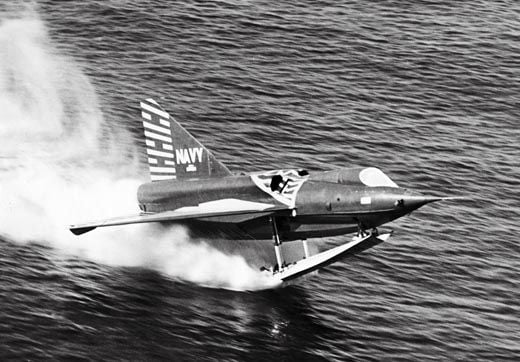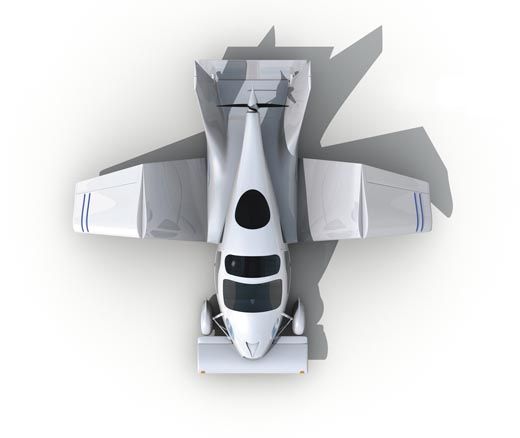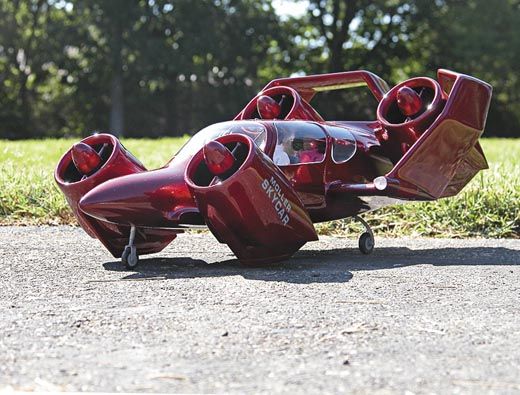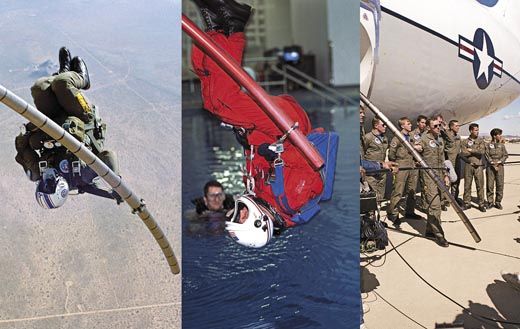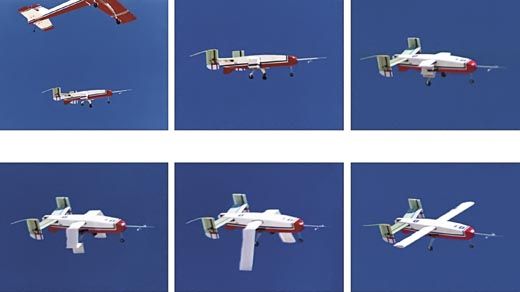The Department of Never Mind
A collection of six inventions that prompt a single question: What the…?
/https://tf-cmsv2-smithsonianmag-media.s3.amazonaws.com/filer/Arch_Nevermind_Flash_SEP09.jpg)
We are convinced that technology's advance would have been smoother if now and then an inventor's best friend had stepped forward to say, "That is not a good idea." We've picked six examples of ideas that probably would have benefited from a little more reflection before the metal was bent. —The Editors
Jet-Ski
It was pure James Bond: A supersonic fighter that took off from and landed on water. Just three years after World War II, Convair (Consolidated Vultee Aircraft Corporation) of San Diego, California, entered a U.S. Navy contest to build a water-based interceptor. Its XF2Y-1 Sea Dart was a midnight blue, delta-wing, twin-engine, supersonic jet with retractable skis for landing gear. The engine intakes sat high to avoid sea spray, giving the craft the appearance of a bodybuilder with rippling shoulder muscles.
Right away, the Sea Dart was treading water. Underpowered by a pair of Westinghouse non-afterburning J-34 engines, each coughing out 3,400 pounds of thrust, the jet stayed stubbornly below Mach 1. Worse, it bounced hard on the waves, and the resulting vibrations jack-hammered the pilot. Convair’s chief test pilot, E.D. “Sam” Shannon, reported that at near-takeoff speeds, the vibrations impaired his vision. Shannon did take off in the XF2Y-1 for the first time on January 14, 1953 — accidentally — on a high-speed taxi that went airborne for about 1,000 feet. The official first flight took place three months later, on April 9.
In August of the following year, Convair test pilot Charlie Richbourg flew a second Sea Dart, the YF2Y-1, powered by stronger Westinghouse J-46 afterburning turbojets, each with 6,000 pounds of thrust, through the sound barrier in a shallow dive at 34,000 feet. The Sea Dart became the only seaplane ever to go supersonic. But even with the more powerful engines, it never broke the sound barrier in level flight.
By then, the Navy was coming around to the realization that carrier-based jets were an all-around better option than seaplanes. In the midst of this shift, on November 4, 1954, Richbourg made a high-speed pass in the Sea Dart for some reporters and Navy brass assembled along the San Diego Bay. Rocketing by at 575 mph, he lit the afterburners. The kick from the high-mounted engines pitched the airplane's nose down. When Richbourg tugged back on the stick to correct it, the jet entered a divergent, or progressively severe, pitch oscillation, and broke up almost immediately. The accident killed him and the rest of the dwindling support for the program. Though the Navy granted the Sea Dart three more years of experimental status with dual and single skis of various designs, it cancelled orders for production versions.
Convair pilot B.J. Long, the Sea Dart’s lone surviving test pilot, recalls his final flight, made on January 16, 1956. “It just about broke my back,” he says by phone from his home in southern California. Taking off on the calm water of the bay, he flew out to open sea, where the test called for setting the seaplane down in swells ranging from six to 12 feet. As he did so, his helmet smashed the interior of the cockpit with such force that he thought he tasted blood (later, he found that the impacts had driven mucus from his sinuses into his mouth). The ensuing takeoff was almost catastrophic. Keeping the nose high to avoid piercing the waves, he ricocheted off their crests, a ride that slammed him ruthlessly at 9 Gs and left him dazed as the airplane took flight.
Now 86, he says a heart attack and bypass surgery late in life are unrelated to his 187 landings in the Sea Dart. “But that final flight,” he jokes, “that gave me my brain damage.”
—Michael Klesius
Does This Make Me Look Fast?
In September 2008, airline pilot and skydiver Yves Rossy exited a Pilatus Porter at around 9,000 feet, unfolded an eight-foot composite wing strapped to his back, fired the wing’s four small turbines, and screamed 22 miles across the English Channel, reaching 186 mph. After 10 minutes, nearing the White Cliffs of Dover, Rossy deployed a parachute and fluttered down into a field near the South Foreland lighthouse, which Louis Blériot had targeted in his historic 1909 cross-channel flight in a wobbly monoplane.
Five years before Rossy’s flight, Austrian BASE jumper Felix Baumgartner, wearing a six-foot composite wing and an oxygen tank, exited an airplane at 30,000 feet and free-fell across the channel, reaching 220 mph.
Like father and son Knievel’s motorcycle jumps, these latest channel crossings have made great videos and, in the YouTube era, have entertained thousands. But now that the channel has been crossed by all conceivable modes of transport — thanks anyway, we’ll take the Chunnel.
—Patricia Trenner
In Case of Emergency…
In his 2006 book Riding Rockets, NASA mission specialist and three-time space traveler Mike Mullane expresses unvarnished skepticism over the bailout system created for the orbiters after the Challenger tragedy. “We would jump out the side hatch just like B-17 crewmembers did in WWII,” Mullane writes. “Good freakin’ luck!”
Early escape concepts employed rocket-propelled lanyards to yank astronauts from the hatch, a technology affectionately called the Yankee Extraction System when it was used in Vietnam to uncork pilots from ejection seat-less A-1 Skyraiders. But having rockets sitting around on the shuttle was too dangerous, and the idea was scrapped in favor of a curved, telescoping pole fixed to the ceiling of the mid-deck that the crew would extend out of the hatch. Each astronaut would clip the harness on his suit to a ring on the pole and slide off the end, passing beneath the wing of the orbiter. A backpack parachute would then open automatically.
The system was realistic only for an orbiter in controlled, gliding flight at subsonic speeds and below 50,000 feet. It’s difficult to imagine failure scenarios in such a benign profile that would cause a crew to ditch a $2 billion orbiter.
Former mission specialist Tom Jones can think of a few. Over the course of four shuttle flights, he was sometimes the guy near the door who would have blown the hatch and gone out first, and at other times one of those upstairs who might have gone out last.
One scenario, he says, is that a critical navigation error has put the orbiter way off course, perhaps threatening a populated area and requiring the crew to point the craft toward a desert or an ocean, and get out. “If you make it through the reentry, though,” he admits, “it’s highly improbable that you’d somehow not make it to the runway.”
The most realistic event? Jones says that would be an abort high above the Atlantic, minutes into the climb, in which the orbiter sheds its spent boosters, drops its fuel tank, and tries to glide back to the Florida launch site but can’t quite make it. In the end, Jones says, “it just has to be what’s called ‘a good day.’ Our instructors and flight controllers didn’t sugar-coat our chances. But I think it’s worth the development and testing costs. It gives a few people the chance to get out. It gives you a straw to grasp at.”
Shuttle veteran Sid Gutierrez recalls using his expertise as an engineer and experienced skydiver to advise NASA on escape systems. Most failed to materialize not because they were harebrained, he says, but because they were too complex and expensive, requiring a redesign of the orbiters. One idea was to design ejection “pods,” like those for B-58 and XB-70 pilots, which would enclose and eject each astronaut, making egress at higher speeds and altitudes more survivable. Another would have separated the whole front end of the orbiter from the rest.
But the best idea, insists Gutierrez, was to put everyone, pilots included, in a large capsule in the payload bay during launch and reentry, and automate those phases of the flight. The capsule would be durable enough for reentry on its own, followed by an Apollo-style parachute deployment, and would therefore provide an escape for any phase of the mission. It would double as a roomy airlock prior to spacewalks, and generally furnish more elbowroom in orbit. “The elegance of sticking this thing in the payload bay was that there’s no redesign,” says Gutierrez. “It would have been survivable for both accidents we’ve had, which were worst-case scenarios.” But even this idea seemed too expensive to many of the higher-ups at NASA. Says Gutierrez, “I explained to a couple NASA administrators that nothing is more expensive than an accident.”
As for Mullane’s final judgment on what the astronaut corps ended up with? “Many of us placed the slide-pole bailout procedures in the same category as the pre-Challenger contingency-abort procedures — busywork while dying.”
—Michael Klesius
Another Flying Car? Meh.
I hereby name Terrafugia’s Transition most awesome airplane of the year, and I want it to succeed in every way; I really do. But history is not on its side. That may be the reason that the Massachusetts-based company’s co-founder Carl Dietrich refers to the Transition as a “roadable aircraft” instead of as a “flying car.”
A flying car has been a goal of daydreaming engineers, professional and amateur, for at least 90 years. Between 1918 and 1993, 76 U.S. patents for flying cars were issued. Notable efforts include Robert Fulton’s 1946 Airphibian, Waldo Waterman’s 1937 Arrowbile, the 1950s Bryan Roadable, and Molt Taylor’s much-photographed 1950s Aerocar, one of which was still flying in the mid-1990s. In recent years, Paul Moller’s Skycar, in the works since 1965 and ultimately powered by eight Wankel-type rotary engines, has made headlines — largely for the millions Moller has poured into the project. In what he calls “an exercise in evaluation,” Moller placed an early prototype on eBay last October. “We wanted to see what it might fetch,” he says. He set the price he was willing to accept at $3.5 million, and withdrew after the highest bid reached close to $2 million. According to Moller, he has 67 orders, but not enough capital investors.
Terrafugia investors expect customers to be driving/flying early in 2010. Fabricated of composites, the Transition qualifies for the Federal Aviation Administration class of light-sport aircraft, weighing under 1,320 pounds. It runs on gasoline, has a 460-mile range, and will cost just under $200,000. Flight testing of the proof-of-concept vehicle was completed last spring, with 28 flights. Next up: a beta prototype design. So the technology is there and so is the excitement, but show me the market.
Despite the best intentions, all flying car projects have eventually ground to a halt, due largely to colossal indifference in the marketplace.
—Patricia Trenner
The Airline Idea that Got Flushed
A lunchtime chat among four co-workers at IBM led to one of the oddest aviation patents ever issued: a computer system for airline passengers to make reservations to use the restroom.
“I had started a lunch group and we’d meet once a week,” recalls Sam Dinkin, then an economist at IBM’s T.J. Watson Research Center in Yorktown Heights, New York. “The discussion at the time was about blood clots and how someone had died on an airliner of deep-vein thrombosis. Then someone mentioned that somebody also had died of a broken neck in turbulence, and we all thought, ‘Well why should anybody be standing up waiting to use the bathroom?’ We’ve got the technology to organize a queue.”
By the summer of 2000, Dinkin, along with co-workers Stephen Bois, Paul Moskowitz, and Phillip Yu, had designed a computer system that could schedule bathroom use either on a first-come, first-served basis or by ranking requests, according to such factors as seating class, ticket price, or frequent-flier status. Then it would electronically notify passengers when it was their turn to go. The result: “System and Method for Providing Reservations for Restroom Use,” U.S. patent no. 6,329,919, issued December 11, 2001.
“It seemed to us like a long shot that it would even be granted,” says Dinkin, now living in Austin, Texas. “Every idea has to be a little bit kooky. If not, someone would have thought of it and filed for it a long time ago.” The inventors had expected that the Federal Aviation Administration would issue new rules about standing in commercial aircraft, especially in light of the September 11, 2001 attacks, in which some hijackers had queued to use the first-class restroom before taking over the airplanes.
What Dinkin and the others hadn’t expected were the howls of criticism from the media, which both ridiculed the invention and held up the U.S. Patent and Trademark Office as an example of a wasteful bureaucracy. The next year, IBM quietly withdrew the patent.
Today, Dinkin holds no grudges. “If I were IBM, I wouldn’t want any tarnish from it. No one anticipated that it would be a particular patent held up to ridicule,” he says. As for the patent itself, “I’m happy to put my name on it. It’s called ‘the potty patent.’ Whenever I’m in a conversation with [intellectual property] attorneys, we can have a great discussion. I just wish I had donated it to a charity, rather than let it go into the public domain.”
—Paul Hoversten
Inflated Hopes
Think of rubber aircraft, and the Goodyear blimp probably springs to mind. But Goodyear, the company best known for tires and rigid airships, was also responsible for a 1950s invention called the Inflatoplane. An inflatable rubber airplane, it was to rescue downed pilots (when folded, the aircraft was stored in a suitcase that could be dropped behind enemy lines). The idea wasn’t new; inventor Taylor McDaniel had filed a patent in 1930 for an inflatable glider, and the British magazine Flight reported in the mid-1930s that the Soviets were producing a rubberized glider with inflatable tubes that weighed only 93 pounds and could taxi on land or sea. Goodyear’s version, which weighed 225 pounds, had a wingspan of 22 feet, and could cruise at about 60 mph, almost as fast as a Piper J-3 Cub. The aircraft held 20 gallons of fuel, could carry a maximum weight of 240 pounds, and had a range of 390 miles. Testing was slow: “We’ve just been flying them gingerly around so far,” a Goodyear manager told the Washington Post in April 1959. When test pilot Richard Ulm took the Inflatoplane to 5,000 feet to test its dive capabilities, a wing buckled, requiring Ulm to abandon the craft. (A helicopter rescued him after he parachuted into a tree.)
By 1959, the Department of Defense came up with its own version of the idea: Project Wagmight. Unlike the Inflatoplane, the military craft would be unmanned. Planners envisioned inflatable rubber aircraft carrying large nuclear warheads 1,500 miles. The airplanes “could be launched from ships, surfaced submarines, or large Army trucks with a simple catapult or rocket-assisted launcher,” reported the Washington Post. Advocates claimed that a carrier could store 1,000 deflated aircraft, versus the standard 80 metal airplanes. Nonetheless, the project was dropped in the early 1960s.
Goodyear’s Inflatoplane also deflated. To take off, the vehicle needed a flat area not easily found in the jungles of Vietnam. “It was just one of those things that didn’t really have a practical application,” says Dik Daso, aeronautics curator with the National Air and Space Museum. “If you could drop this thing to a pilot, well, you could probably pick him up with a helicopter too.” After building 12 Inflatoplanes, Goodyear canceled the project in 1973.
But the aeronautical oddity best “consigned to a niche...where small children and junior birdmen might gawk [at it],” as one reporter wrote, inspired other uses. NASA developed one unmanned aerial vehicle, the I2000, with a viable inflatable wing. And the University of Kentucky’s BIG BLUE student project proved that inflatable vehicles are feasible for planetary research: In a craft traveling to Mars, space will be tight, so any probe that can reduce its size before deployment is extremely valuable.
In 1973, Goodyear donated an Inflatoplane to the National Air and Space Museum; it will eventually be displayed at the Steven F. Udvar-Hazy Center.
—Rebecca Maksel
